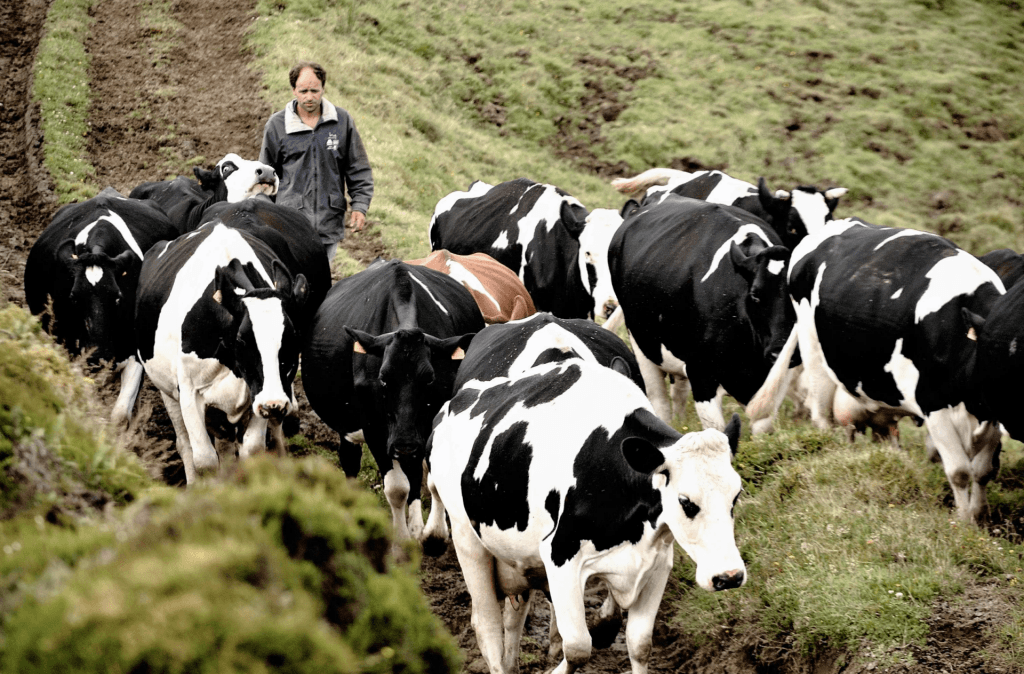How human and animal excrement harm the planet’s ecosystem
By Laura H. Kahn | November 14, 2019
 Cows emit potent greenhouse gases as they digest food. The vast amount of manure they produce is also contributing to the spread of antibiotic resistance. Credit:
Feliciano Guimarães. (Creative Commons.)
Cows emit potent greenhouse gases as they digest food. The vast amount of manure they produce is also contributing to the spread of antibiotic resistance. Credit:
Feliciano Guimarães. (Creative Commons.)
As Taro Gomi’s famous children’s book says, “All living things eat, so everyone poops.” Indeed, 7.6 billion humans and their domesticated animals are estimated to produce at least 4 trillion kilograms of poop each year—enough to fill approximately 1.6 million Olympic-sized swimming pools. The massive amount of human and animal excrement that we and our domesticated animals produce is changing the ecosystem of our planet in dangerous ways.
All this poop has to go somewhere, and much of it gets spread on agricultural fields as fertilizer. Soils need the microbes and nutrients in manure to be healthy, but we’re not managing manure properly, and the mismanagement is causing serious environmental and health problems. Current methods for managing and using agricultural manure—domesticated animals account for about 85 percent of the feces produced in a year—spread antimicrobial resistance genes, contaminate crops and waterways with microbes, and produce potent greenhouse gas emissions such as methane and nitrous oxide.
Poop is spreading antimicrobial resistance. Excessive antibiotic use in humans and animals has resulted in an increase in the number of resistant bacteria in the environment. Those bacteria can be found in the vast quantities of human and animal feces modern civilization and agriculture produce—a waste stream that, when it mixes with soil, helps to spread antibiotic resistance to other microbes at alarming speed. Research on DNA in the soil is shedding light on the scope of the problem.
For decades, nobody knew what microbes existed in the soil, because most soil microbes couldn’t be cultured in laboratories. This changed once scientists began using a new technology called metagenomics to extract DNA directly from the soil. Metagenomics can assess the genetic material present in environments. While the technique doesn’t allow researchers to identify individual microbes, the DNA soil findings were nonetheless astounding. Antibiotic resistance genes were everywhere, including in soils from the Arctic, the Antarctic, and other areas that had never received anthropogenic antibiotic exposure. These antibiotic resistance genes appeared to be ancient and to pre-date human antibiotic use.
Microbes appear to use antibiotics as a form of communication. To handle these antibiotics, microbes have evolved resistance genes. To describe the spread of these genes, scientists have coined a term: “the global resistome.” Excessive use of antibiotics in medicine and agriculture have affected this world wide web of resistance genes. By inundating the planet with manure–exposing soils to antibiotics and to antibiotic resistance genes–we are changing its microbial ecology. As a result, microbes are sharing antibiotic resistance genes with each other. And they are doing this much faster than pharmaceutical companies can develop new antibiotics.
Cattle, manure, and climate change. Of course, animal manure is doing more than just helping spread antibiotic resistance; it’s also contributing to climate change. Massive amounts of manure emit methane and nitrous oxide, which are much more potent greenhouse gases than carbon dioxide. Ruminant animals like cows also produce emissions when they belch or pass gas. These manure and digestive emissions account for 7 percent of global greenhouse gas emissions. The chief offenders responsible for this alarming figure are beef and dairy cattle, which produce about 62 percent of such emissions. The amount of methane produced during the process by which cows and other ruminants digest food, which is called enteric fermentation, varies depending upon feed quality and composition.
Policies to reduce livestock emissions must focus on three areas: enteric fermentation, manure management, and feed management. The good news is there are some methods that can help. High feed quality and feed additives such as bromoform, an organic compound found in seaweed, may reduce methane emissions from enteric fermentation by 50 to 90 percent, but the compounds still require more testing. Storing manure in liquid form in ponds or lagoons emits more methane than storing it in solid form. Methane digesters, meanwhile, can capture the gas emitted from manure and convert it to renewable energy. However, these technologies are not cheap and require financial incentives if they are to be widely adopted; Europe has embraced such incentives more effectively than the United States has.
The massive amounts of human and animal feces produced each year require improved national and international policies and state-of-the-art technologies to address the impacts it has on global health, the planet’s biome, and the atmosphere. If we want to live sustainably in our microbial world, we need to address poop.
Together, we make the world safer.
The Bulletin elevates expert voices above the noise. But as an independent nonprofit organization, our operations depend on the support of readers like you. Help us continue to deliver quality journalism that holds leaders accountable. Your support of our work at any level is important. In return, we promise our coverage will be understandable, influential, vigilant, solution-oriented, and fair-minded. Together we can make a difference.
Keywords: antibiotic resistance, antibiotic resistance genes
Topics: Analysis, Biosecurity














